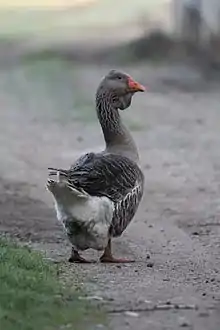Toulouse goose
The Toulouse is a French breed of large domestic goose, originally from the area of Toulouse in south-western France. Two types are recognised: a heavy industrial type with dewlaps, the French: Oie de Toulouse à bavette;[6] and a slightly lighter agricultural type without dewlaps, the French: Oie de Toulouse sans bavette.[5] Both types are large, with weights of up to 9 kg.[10] Birds bred in the United Kingdom and United States exclusively for showing may be still larger, and have a somewhat different conformation.[11]:378
 The "à bavette" or "with dewlap" type | |
| Conservation status |
|
|---|---|
| Other names | |
| Country of origin | France |
| Use |
|
| Traits | |
| Weight | |
| Egg color | white[4] |
| Classification | |
| APA | heavy goose[7] |
| EE | yes[8] |
| PCGB | geese: heavy[9] |
| |
History
The original grey-coloured breed is a very old one and the name has been recorded back as far as 1555. The breed was first brought to the United Kingdom by Lord Derby in 1840, who imported some of them to England,[11]:378 and from then onwards the French Toulouse were used as breeding stock with the consequence that by 1894, English breeders had produced a massive bird. The 'Toulouse' in France, although kept in greater numbers, have never quite equalled such weights. The breed was later brought to North America, where it became popular in the upper Midwest due to its ability to withstand cold winters.[3]
Characteristics
The Toulouse generally has a placid disposition.[12] Ring size is 27 mm for both ganders and geese.[13] In France weights range from about 7 to 9 kg. The UK standard calls for an average weight of about 10 kg for geese, and nearly 13 kg for ganders.[11]:379
Use
The production strain of the Toulouse goose was bred to be fast growing, gaining weight rapidly when there is an abundance of food and no room for exercise.[14] It is thus an important meat producer and, with its oversized liver, a source of foie gras.[3] Geese of the type without dewlaps lay 25–40 eggs extra-large white eggs per year, while geese of the dewlap type lay 20–35.[4] The birds may also be a source of goose down.[3]
References
| Wikimedia Commons has media related to Toulouse geese. |
- Barbara Rischkowsky, D. Pilling (eds.) (2007). List of breeds documented in the Global Databank for Animal Genetic Resources, annex to The State of the World's Animal Genetic Resources for Food and Agriculture. Rome: Food and Agriculture Organization of the United Nations. ISBN 9789251057629. Accessed February 2016.
- Geese. Poultry Club of Great Britain. Archived 9 November 2018.
- Dohner, Janet Vorwald (2001). The encyclopedia of historic and endangered livestock and poultry breeds. New Haven: Yale University Press. p. 472. ISBN 9780300138139.
- Toulouse Goose. The Livestock Conservancy. Accessed February 2016.
- Breed data sheet: De Toulouse Sans Bavette (type agricole)/France. Domestic Animal Diversity Information System of the Food and Agriculture Organization of the United Nations. Accessed February 2016.
- Breed data sheet: De Toulouse A Bavette (type industriel)/France. Domestic Animal Diversity Information System of the Food and Agriculture Organization of the United Nations. Accessed February 2016.
- APA Recognized Breeds and Varieties: As of January 1, 2012. American Poultry Association. Archived 4 November 2017.
- Liste des races et variétés homologuée dans les pays EE (28.04.2013). Entente Européenne d’Aviculture et de Cuniculture. Archived 16 June 2013.
- Breed Classification. Poultry Club of Great Britain. Archived 12 June 2018.
- Hugo, Susanne (1995). "Geese: the underestimated species". World Animal Review. 83 (2): 64–67. Archived from the original on 13 January 2003.CS1 maint: unfit URL (link)
- Victoria Roberts (2008). British poultry standards: complete specifications and judging points of all standardized breeds and varieties of poultry as compiled by the specialist breed clubs and recognised by the Poultry Club of Great Britain. Oxford: Blackwell. ISBN 9781405156424. p. 378–380.
- Native Poultry Breeds at Risk Archived 1 July 2014 at the Wayback Machine. Rare Breeds Survival Trust. Accessed February 2016.
- Liste des races et variétés de Gallinacés et Palmipèdes domestiques et diamètres des bagues en mm (in French). Fédération française des volailles. Accessed February 2016.
- Jacob, Jacquie; Pescatore, Tony. "Selecting Geese" (PDF). University of Kentucky, College of Agriculture, Food and Environment, Cooperative Extension Service. Retrieved 26 February 2016.
Further reading
- Joseph Batty (1996). Domesticated Ducks and Geese, third edition. Elsted, Midhurst: Beech Publishing House. ISBN 9781857360912.